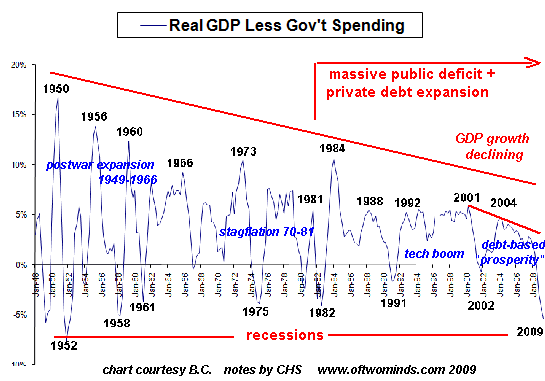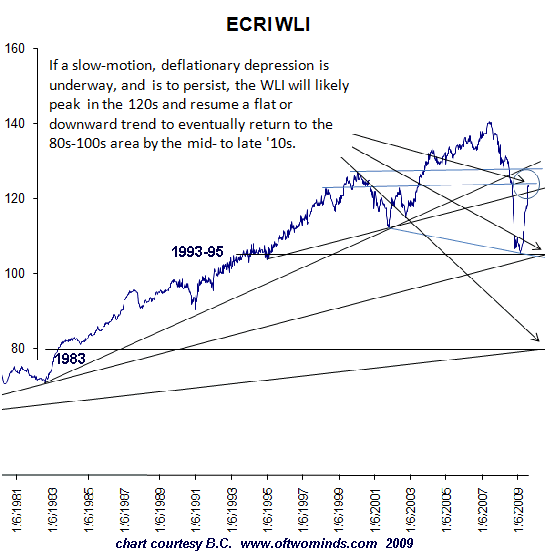Welcome to America's "Lost Decade(s)"
Many have commented on the parallels between Japan's "Lost Decade" of 1991-2000 and the U.S. now that the housing bubble has popped. Ushinawareta junen is the Japanese phrase for "Lost Decade." The term describes the 1991-2000 no-growth decade in which Japan attempted to defeat debt-liquidation deflationary forces with massive government borrowing and spending, and a concurrent bailout of "zombie" (insolvent) banks with government funds. The central bank's reflation failed. By any measure, the Lost Decade is now the Lost Decades. Japan's economy enjoyed a brief spurt from America's real estate bubble and China's need for Japanese factory equipment and machine tools. But now that those two sources of demand have ebbed, Japan is returning to its deflationary malaise. Lost Decade (Japan) (Wikipedia) Correspondent B.C. recently provided several charts and a commentary on the parallels. It seems the key parallel is this: an asset bubble inflated with highly leveraged debt pops and the value of real estate and stocks declines. But the high levels of debt taken on to speculate in stocks and housing remain. Rather than let the private-sector which accepted the high risks and took the enormous profits take staggering losses and writedowns, the government and central bank shift the losses from the private sector to the public balance sheet via bailouts and outright purchases of toxic/impaired private debt. As I recently described in The Final Demise of A Speculative Housing Bubble, this is precisely what the Fed and Treasury are doing in the U.S.: increasing public (Federal government) debt by trillions of dollars to shift the private-sector "bad loans" to the public balance sheet. It didn't work in Japan and it won't work in the U.S. Here are B.C.'s charts: Note how the GDP growth rates have been diminishing for decades, and the anemic growth rate of the 2002-2006 debt-fueled housing-bubble "prosperity." B.C. provided these comments: The WLI is overweighted by stock prices, money supply, and the yield curve, which during inflationary/reflationary periods is appropriate and serves to anticipate reflationary cycles. However, none of these models have been tested during debt- and price-deflationary eras, when a flatter yield curve at lower nominal yields and slower trend money supply growth and nominal GDP do not yield the same reflationary growth coming out of cyclical recessions within secular depressions. Some will infer from the chart that a V-shaped recovery is imminent, but we did not have in the 1950s and 1970s-80s the massive private and public debt burden and scale of Boomer demographic drag we have today; nor did we have China and India competing for resources on a global scale with the potential for peak fossil fuel production occurring. Also note that when the ECRI WLI's growth rate was at or near today's level ('71, '83, and '03), the economy had already begun expanding above potential at 3-5% yoy, total industry capacity utilization was at 75-80 (68-69 today), personal income was growing at 5-7% to 10-12%, corporate profits after tax were growing at 20%+, private fixed investment was growing 10-20%, GDP less gov't was growing strongly yoy, and employment had begun growing again. Thus, it is "different this time", but not in the way Bulls might think or want it to be. I asked B.C. about savings rates and deflation, and he added these observations: That the Boomer demographic drag is just beginning, likewise, the mass-liquidation and drawdown of assets (liquidation of savings) has barely begun. Keep in mind that such a deflationary outcome simply cannot occur (or be allowed to occur), let alone persist, in a post-industrial, Neo-Keynesian, debt-money-based system. The only solution to debt and asset deflation and liquidation of savings is more debt-money in an attempt to keep "money-illusion" effects going to support debt-money-based assets. The more debt added atop a system begging to be liquidated only increases the scale of future liquidation and ensures a protracted period of little or no private sector growth. The credibility and even existence of the central bank, gov't, and debt-money system is at stake were the natural process of liquidation to be permitted to occur; however, the process is occurring, only in a slow-motion manner, which was the predictable outcome given the Japanese precedent to date. Shifting debt from the private sector to the federal gov't does not solve the problem of insufficient private liquid savings, cash flow, incomes, and profits to service the existing debt. Secular bear markets and deflationary depressions are primarily periods of "wealth consumption" (as compared to a period of "wealth creation" of a secular bull period), which includes asset liquidation, drawdown of assets, mass-consolidation of capacity (and falling book value), and higher taxes and gov't/GDP (gov't consumption, if you will). (emphasis added CHS) Part of the liquidation and wealth consumption will be selling stocks and shifting money to cash, some corporate bonds, and US gov't paper. B.C. also offered these links: U.S. leading Indicators: leading us on? Michael Panzner Weak consumer spending will last for years (Credit Writedowns blog) Secular inflation will be non-existent. Therefore, the problem is a lack of demand for loans not a lack of supply. The Federal Reserve can print all the money it wants. But, if there is little demand for more indebtedness, it is not going to have the desired effect of permanently reflating the economy. Thank you, B.C. for the charts and explanation. Since the rest of the world is also over-indebted and transferring private-sector losses to public balance sheets via massive government borrowing, we cannot expect an export boom to offer us the temporary respite Japan enjoyed in the 2002-06 period. If we started our Lost Decade with 2008's financial meltdown, then 2017 may well mark the first decade of a lost generation. "Your book is truly a revolutionary act." Kenneth R.

The WLI is the Weekly Leading Index compiled and published by theEconomic Cycle Research Institute.
The US is not savings short; rather, savings is in a different form, which is leveraged and highly overvalued versus cash flow, profits, and overall trend of economic growth hereafter. One function of debt, asset, and price deflation is to force the liquidation of the financial system to more efficiently reallocate savings and the capital stock. The most overvalued and overcapitalized assets, stocks and real estate, must be liquidated over time to bring values and allocation into equilibrium.
When debt levels are enormous, as they are right now in the United States, an economic downturn becomes existential for a great many forcing people to reduce debt. Recession lowers asset prices (think houses and shares) while the debt used to buy those assets remains. Because the debt levels are so high, suddenly everyone is over-indebted. Many are technically insolvent, their assets now worth less than their debts. And the three D’s come into play: a downturn leads to debt deflation, deleveraging, and ultimately depression. The D-Process is what truly separates depression from recession and why I have said we are living through a depression with a small ‘d’ right now.
Permanent link: Welcome to America's "Lost Decade(s)"
If you want more troubling/revolutionary/annoying analysis, please read Free eBook now available: HTML version: Survival+: Structuring Prosperity for Yourself and the Nation (PDF version (111 pages): Survival+)
Of Two Minds is now available via Kindle: Of Two Minds blog-Kindle
Thank you, Chad D. ($20), for your exceedingly generous donation to this site. I am greatly honored by your support and readership.



























